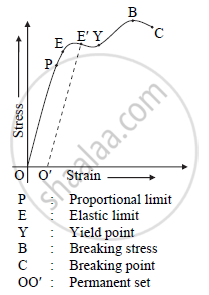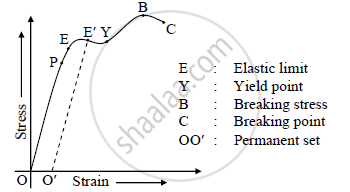Advertisements
Advertisements
प्रश्न
Discuss the behaviour of wire under increasing load.
Explain the behaviour of metal wire under increasing load
उत्तर १
Stress v/s strain graph:-

The behaviour of wire under increasing load can be explained with the help of stress v/s strain graph.
a. Proportional limit: The initial portion OP of the graph is a straight line indicating stress is directly proportional to strain. Thus Hooke’s law is completely obeyed in the region OP. Point P is called point of proportional limit.
b. Elastic limit: Beyond the point P, the stress-strain variation is not a straight line as indicated by the part PE of the graph.
If the wire is unloaded at point E, the graph between stress and strain follows the reverse path EPO, then the point E is called elastic limit. The portion between O and E is called elastic region.
c. Permanent set: If the load is increased so that stress becomes greater than that corresponding to the point E, the graph is no longer a straight line and the wire does not obey Hooke's law. If the wire is strained upto E beyond point E and then the load is removed, the wire does not regain its original length and there is a permanent increase in length. A small strain corresponding to OO' is set up permanently in the wire, called permanent set. However, the wire is still elastic and if loaded again, gives a linear relation shown by the dotted line O'E'.
d. Yield point: As the stress is increased beyond the elastic limit the graph is a curve and reaches a point Y where the tangent to the curve is parallel to the strain axis. This shows that for the stress corresponding to point Y the strain increases even without any increase in the stress. This is known
as plastic flow.
Point Y on the curve is called yield point.
The value of stress corresponding to yield point is called yield stress.
e. Breaking stress: When the wire begins to flow, its cross-section decreases uniformly and hence, the stress increases steadily. Later a neck or constriction begins to form at a weak point. The maximum stress corresponding to the point B is breaking stress.
f. Breaking point: Once the neck is formed, the wire goes on stretching even if the load is reduced, until the breaking point C is reached when the wire breaks.
Elastic limit:-
The maximum stress to which an elastic body can be subjected without causing permanent deformation is called as elastic limit.
Yield point:-
The point on stress-strain curve at which the strain begins to increase without any increase in the stress is called yield point.
Breaking point:-
The point on stress-strain curve at which the wire breaks, is known as the breaking point.
उत्तर २

a) Elastic limit: The initial portion OE of the graph is a straight line, which indicates that upto the point E stress is directly proportional to strain. Hence, Hooke’s law is obeyed upto point E. In this region, wire is perfectly elastic and it completely regains its original length when the load is removed. Point E represents limit of proportionality between stress and strain.
b) Permanent set: If the load is increased so that stress becomes greater than that
corresponding to the point E, the graph is no longer a straight line and the wire does not obey Hooke's law.
If the wire is strained upto E′ beyond point E and then the load is removed, the wire does not regain its original length and there is a permanent increase in length. A small strain corresponding to OO' is set up permanently in the wire, called permanent set. However, the wire is still elastic and if loaded again, gives a linear relation shown by the dotted line O'E′.
c)Yield point: As the stress is increased beyond the elastic limit the graph is a
curve and reaches a point Y where the tangent to the curve is parallel to the strain
axis. This shows that for the stress corresponding to point Y the strain increases
even without any increase in the stress. This is known as plastic flow.
Point Y on the curve is called yield point.
The value of stress corresponding to yield point is called yield stress
e) Breaking point: Once the neck is formed, the wire goes on stretching even if the load is reduced, until the breaking point C is reached when the wire breaks.
APPEARS IN
संबंधित प्रश्न
A steel wire having cross sectional area 1.5 mm2 when stretched by a load produces a lateral strain 1.5 x 10-5. Calculate the mass attached to the wire.
(Ysteel = 2 x 1011 N/m2, Poisson’s ratio σ = 0.291,g = 9.8 m/s2)
The graph between applied force and change in the length of wire within elastic limit is a.......................
- straight line with positive slope.
- straight line with negative slope.
- curve with positive slope.
- curve with negative slope.
A uniform steel rod of 5 mm2 cross section is heated from 0°C to 25°C. Calculate the force which must be exerted to prevent it from expanding. Also calculate strain.
(α for steel = 12 x 10-6/°C and γ for steel = 20 x 101ON/m2)
The area of the upper face of a rectangular block is 0.5 m by 0.5 m and the lower face is fixed. The height of the block is 1 cm. A shearing force applied at the top face produces a displacement of 0.015 mm. Find the strain and shearing force.
(Modulus of rigidity: η = 4.5 x 1010 N/m2)
A steel wire-of diameter 1 x 10-3m is stretched by a force of 20 N. Calculate the strain energy per unit volume.(Y steel= 2 x 1011 N /m2)
Velocity of transverse wave along a stretched string is proportional to _______. (T = tension
in the string)
(A) `sqrtT`
(B) `T`
(C) `1/sqrtT`
(D) `1/T`
A small body of mass 0.3 kg oscillates in vertical plane with the help of a string 0.5 m long with a constant speed of 2 m/s. It makes an angle of 60° with the vertical. Calculate tension in the string (g = 9.8 m/s2).
A steel wire having cross-sectional area 2 mm2 is stretched by ION. Find the lateral strain produced in the wire. (Given : Y for steel = 2 x 1011 N / m2, Poisson's ratio δ = 0.29)
A metal rod having coefficient of linear expansion (α) and Young’s modulus (Y) is heated to
raise the temperature by ΔΘ. The stress exerted by the rod is _______
A) `(Yα)/(ΔΘ)`
B) `(YΔΘ)/α`
C) YαΔΘ
D) `(αΔΘ)/Y`
Calculate the strain energy per unit volume is a brass wire of length 3 m and area of cross - section 0.6 mm2 when it is stretched by 3 mm and a force of 6 kgwt is applied to its free end.
